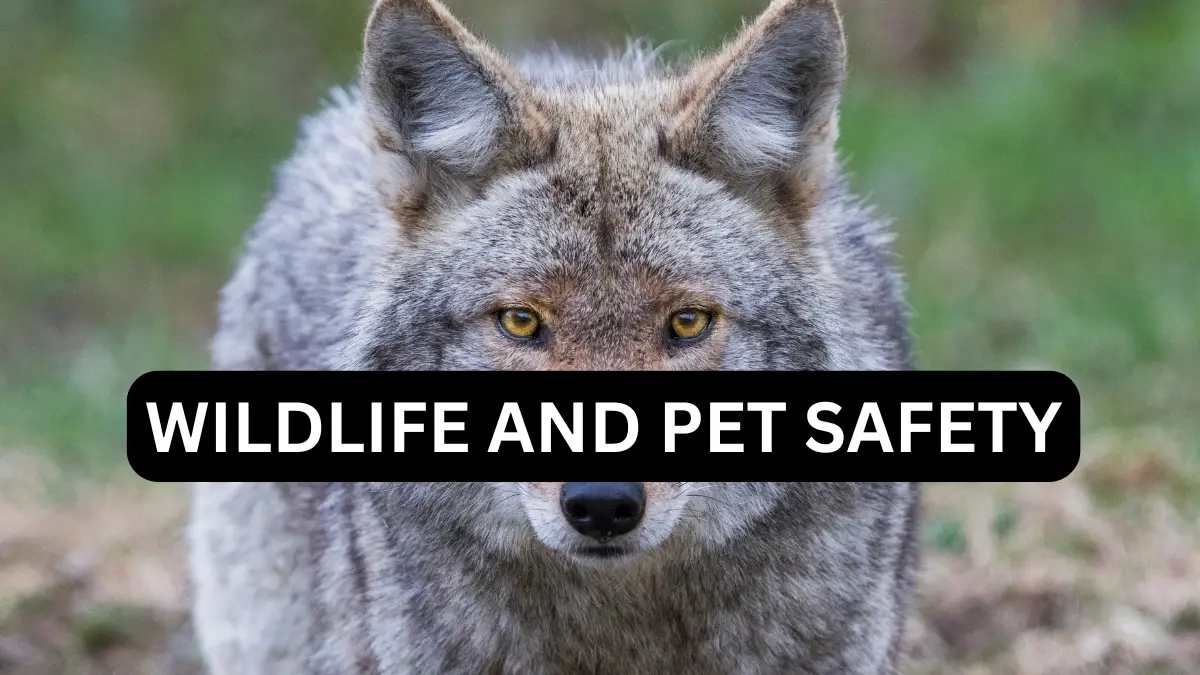Understanding Coyotes in Western Massachusetts: Coexisting with Nature’s Adaptable Predators -3 Things to Keep on your Radar
Understanding Coyotes in Western Massachusetts: Coexisting with Nature’s Adaptable Predators -3 Things to Keep on your Radar Facebook Youtube Tiktok Instagram As a traveling pet sitter, it’s important to understand not only the pets you are taking care of, but to know the environment…
Understanding Coyotes in Western Massachusetts: Coexisting with Nature's Adaptable Predators -3 Things to Keep on your Radar
As a traveling pet sitter, it’s important to understand not only the pets you are taking care of, but to know the environment and the area to which you are staying. In Western Massachusetts, there is wildlife, and we want to share more about coyotes as we had a recent encounter and want to promote pet safety while pet sitting and general information. Learn More about Bears in Southern New England.
Coyotes in Western MA
Coyotes have become a prominent part of the ecosystem in Western Massachusetts, adapting remarkably well to both rural and suburban environments. As their populations continue to grow, it’s essential for residents to understand these adaptable creatures and learn how to coexist safely with them. This article explores the presence of coyotes in the region, their behaviors, and practical ways to minimize potential conflicts, especially when living with pets or farming livestock.
Coyote Characteristics and Behavior
Coyotes (Canis latrans) are highly adaptable predators native to North America. They typically weigh between 20 to 50 pounds and have a bushy tail and pointed ears. Their fur color varies from grayish-brown to reddish-brown, providing excellent camouflage in various landscapes. Known for their intelligence and resourcefulness, coyotes can thrive in diverse environments, from forests and grasslands to urban areas.
Coyotes are primarily nocturnal but can be active during the day, especially in regions with little human activity. Their diet is omnivorous, including small mammals, birds, fruits, and vegetables. They are opportunistic feeders, meaning they will eat whatever is available, including human-generated food sources like garbage and pet food if accessible.
Related: Dog Grooming Tips for New Pet Owners
The Rise of Coyotes in Western Massachusetts
Over the past few decades, coyote populations have expanded significantly across Massachusetts. This increase is due to several factors:
Habitat Adaptation: Coyotes have successfully adapted to urban and suburban environments, allowing them to exploit new food sources and thrive in areas with reduced natural predators.
Population Control Efforts on Other Predators: Efforts to control populations of larger predators like wolves and cougars have indirectly allowed coyotes to flourish, filling the ecological niche these predators once occupied.
Reproductive Success: Coyotes have a high reproductive rate, with females capable of producing litters of 4 to 7 pups each year. This adaptability in reproduction ensures their numbers remain stable even with human attempts at control.
Coyote Interactions with Humans and Pets
Coyotes generally avoid direct contact with humans, but interactions have increased as coyotes become more common in residential areas. Conflicts with humans typically arise when coyotes search for food, leading to potential encounters with pets and livestock. Understanding coyote behavior is crucial for preventing negative interactions.
Pets and Coyotes:
Pets as Prey: Small pets, especially cats and small dogs, are at risk if left unattended outdoors. Coyotes might view them as prey, especially during nighttime or early morning hours.
Territorial Behavior: Coyotes may view dogs as competition for territory, leading to aggressive encounters, particularly during the breeding season (January to March).
Livestock and Coyotes:
- Livestock Vulnerability: Coyotes can pose a threat to livestock, particularly sheep, chickens, and calves. Farmers and livestock owners need to implement protective measures to safeguard their animals.
Coexisting with Coyotes: Safety Tips and Strategies
Living in harmony with coyotes involves taking proactive steps to minimize conflicts. Here are some practical tips to help residents in Western Massachusetts coexist safely with these intelligent creatures:
Secure Food Sources:
- Keep garbage securely covered to prevent coyotes from scavenging.
- Avoid leaving pet food outside overnight, as it can attract coyotes and other wildlife.
- Compost responsibly, ensuring no food scraps are left accessible.
Protect Pets:
- Supervise small pets when outside, particularly at dawn and dusk.
- Use leashes while walking dogs, especially near wooded areas where coyotes might be present.
- Install fencing around yards to deter coyotes from entering, ensuring the fence is at least 6 feet high and extends underground to prevent digging.
Safeguard Livestock:
- Use guard animals like dogs, llamas, or donkeys to protect livestock.
- Employ secure enclosures, particularly at night, to prevent coyote access to livestock.
- Implement motion-activated lights or alarms to deter coyotes from approaching barns or enclosures.
Modify Habitats:
- Clear overgrown areas and brush near homes to reduce hiding spots for coyotes.
- Secure any potential denning sites on your property, such as abandoned buildings or under decks.
Be Aware and Educate Others:
- Educate family and neighbors about coyote behavior and the importance of coexistence.
- Report aggressive coyote behavior to local wildlife authorities for further investigation.
Respect Wildlife:
- Do not feed coyotes or any other wildlife, as this encourages them to lose their natural fear of humans.
- Maintain a safe distance if you encounter a coyote in the wild and never attempt to approach or corner them.

The Role of Coyotes in the Ecosystem
Despite the potential conflicts, coyotes play a vital role in maintaining ecological balance. As predators, they help control populations of small mammals and other animals, reducing the spread of diseases and promoting biodiversity. Coyotes also indirectly benefit other species by leaving food scraps for scavengers and controlling pests like rodents.
Coyotes are an integral part of the natural landscape in Western Massachusetts. By understanding their behavior and implementing strategies to minimize conflicts, residents can coexist peacefully with these adaptable animals. Embracing coexistence with coyotes not only fosters a safer environment for humans and pets but also supports the region’s biodiversity and ecological health. Through education and responsible practices, we can ensure that coyotes continue to thrive as valued members of the ecosystem.
Tips for House Sitters if a Coyote is Spotted
| Tip | Description |
|---|---|
| Stay Calm | Do not panic. Coyotes are generally not aggressive toward humans. |
| Secure Pets | Bring pets indoors and keep them supervised at all times. |
| Haze the Coyote | Make loud noises, wave your arms, and assertively tell the coyote to leave. |
| Remove Food Sources | Ensure there is no food left outside that could attract coyotes. |
| Report Sightings | Notify local wildlife authorities if the coyote exhibits unusual behavior. |
| Educate Yourself | Learn more about coyote behavior and safety practices. |

Why Do Coyotes Get Mange?
Mange is a skin disease caused by parasitic mites, and coyotes can become mangy due to infestation by these mites. The most common type affecting coyotes is sarcoptic mange, caused by the mite Sarcoptes scabiei. Here are some reasons why a coyote might develop mange:
Close Contact with Infected Animals: Mange is highly contagious and can spread easily among coyotes or between different species through direct contact. If a coyote comes into contact with an infected animal, it can easily contract the mites.
Dense Populations: In areas where coyote populations are high, the likelihood of transmission increases due to more frequent interactions between individuals.
Weak Immune System: Coyotes with weakened immune systems are more susceptible to mange. Factors such as poor nutrition, stress, or other underlying health issues can compromise a coyote’s immune response, making them more vulnerable to mite infestations.
Environmental Conditions: Conditions that stress coyotes or limit their access to food can weaken their health, making them more susceptible to mange. This can occur in harsh winters or in areas with reduced prey availability.
Habitat Degradation: Human activities that alter or fragment habitats can increase stress levels in wildlife populations, contributing to higher disease susceptibility, including mange.
Natural Spread: Mange can spread naturally within wildlife populations as part of the ecosystem dynamics. Once introduced, the mites can persist and circulate among local wildlife, including coyotes.
Effects of Mange on Coyotes
- Physical Appearance: Coyotes with mange often lose large patches of fur, which can lead to a scruffy appearance. Their skin may become thickened and scaly.
- Health Impact: Severe infestations can lead to secondary infections, malnutrition, and, ultimately, death if untreated.
- Behavioral Changes: Mangy coyotes may exhibit unusual behavior, such as increased boldness or desperation, as their condition deteriorates and they struggle to hunt effectively.
Management and Control: Mange in wildlife is typically managed through natural population controls and environmental health measures. In some cases, wildlife agencies may intervene if the disease poses a significant threat to a particular population or ecosystem.
For more information on coyote behavior and safety measures, consider visiting the Massachusetts Division of Fisheries and Wildlife website or contacting local wildlife experts. They can provide guidance on living with coyotes and offer support for implementing effective coexistence strategies.







